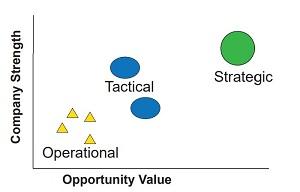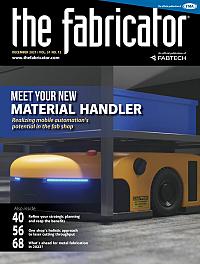Partner
- FMA
- The Fabricator
- FABTECH
- Canadian Metalworking
Categories
- Additive Manufacturing
- Aluminum Welding
- Arc Welding
- Assembly and Joining
- Automation and Robotics
- Bending and Forming
- Consumables
- Cutting and Weld Prep
- Electric Vehicles
- En Español
- Finishing
- Hydroforming
- Laser Cutting
- Laser Welding
- Machining
- Manufacturing Software
- Materials Handling
- Metals/Materials
- Oxyfuel Cutting
- Plasma Cutting
- Power Tools
- Punching and Other Holemaking
- Roll Forming
- Safety
- Sawing
- Shearing
- Shop Management
- Testing and Measuring
- Tube and Pipe Fabrication
- Tube and Pipe Production
- Waterjet Cutting
Industry Directory
Webcasts
Podcasts
FAB 40
Advertise
Subscribe
Account Login
Search
How manufacturers leverage their strengths for sustainable growth
What makes a company strong can make it stronger
- By Steve Zerio
- December 12, 2021
- Article
- Shop Management
“Someone stole $500,000 and I want you to find out who.” It was my first day as CFO at an Ohio fabricator, and the company founder was certain funds were missing. “Every year we make a 40% gross margin, 15 years in a row, and now our 32% margin proves it was stolen,” he bristled as his face turned red. There had been turnover in accounting with a couple of controllers and a CFO gone. “Let me look at the financials and cost records and see what we can find,” I replied as I wondered what I had signed up for.
The shop had not built much of a cost accounting system but was very profitable and got by without much analysis. I recalled my shop floor tour during the interview, where I learned the company had recently launched an equipment line to go with the compression mold tooling it sold. The equipment was topnotch with a lot of automation, including robots and outsourced electronics.
We did some quick analysis on the simple costing to learn that the automation line was making an overall 15% margin—not terrible, but significant enough to bring the average company margin down by 8 percentage points. We worked to get the automation margins up to 20%, but the company made a strategic decision to introduce a significant product line without much planning or analysis. We had to work with half the margin on automation jobs, but the results could have been much worse.
Any move into a new area introduces risk. For instance, if your operation focuses on piece-part fabrication but then expands into assembly, you’re taking on risk. The rewards might outweigh the risks, of course, but how do you know? This is where strategic planning comes into play. Before sailing into uncharted territory, you need to know what makes your boat so strong, how it has stayed afloat even during the toughest of times. Core strengths shouldn’t be based on a hunch, either. Identifying them requires thorough, objective analysis. But once you identify them, you can use them to make your company even stronger.
It’s Hard to Say No
Companies that tackle only the easy jobs for easy customers usually don’t grow and succeed. Customers bring new, unique challenges to their best suppliers. Good salespeople bring in more unique challenges from new customers with problems their existing suppliers haven’t solved.
Tackling all these challenges, a fabricator evolves. That initial niche that set the organization apart turns into a nice business segment or two. It still provides a good core stream of work. But now, after solving challenges for scores of customers, the fabricator does so much more.
Fabricators have a complex mix of products, features, lot sizes, and markets. Some product segments involve complex work with numerous steps beyond cutting, bending, and welding. Other jobs might be pushed through a single, simple operation, then sent to customers who process them further. No approach is automatically better, but shops can’t be everything for everyone, even for their best customers.
Low Versus High Volume
Your shop might excel at short and medium production runs with quick setups and turnaround, four hours or less per operation. This allows for a flexible schedule and quick customer responsiveness. The production team hustles between job setups and parts offloading to keep up with the schedule. The pace is brisk.
That ideal production state is contradicted by the 87% average on-time delivery rate, according to the “Financial Ratios and Operational Benchmarking Survey,” published annually by the Fabricators & Manufacturers Association (FMA). Being consistently late requires frequent expediting, which creates chaos on the shop floor. Managers juggle the production schedule and rack up expensive overtime hours. What sparks all this chaos? Likely culprits are larger-than-typical production jobs that tie up work centers for full shifts and force compromises between machine efficiency and on-time delivery.
I have visited several companies structured for short and medium runs that hope to land a few long-run, high-volume jobs to grow sales. This, alas, is a recipe for disaster. Purchasing, quality, and material handling can’t effectively manage the unique requirements for the long-run jobs, including special lot controls and shipping requirements. Also, the high-volume jobs come with much lower margins and a lot of overhead.

FIGURE 1. Company action plans can be grouped into three categories. Operational tasks are foundational. Tactical plans involve doing the same things differently, like upgrading equipment. Strategic plans build off a company’s strengths and, in doing so, lead to sustainable growth.
Small-lot, quick-delivery jobs that take two hours to produce can be impossible to intermingle with 40-hour production jobs that run through the same work centers. Successful mixed-mode operations tend to run high- and low-volume jobs in separate areas or facilities, each with their own dedicated equipment and staff.
For instance, one company I worked with built an express cell with its own staff and equipment for flame cutting, grinding, machining, and assembly of simple die sets. Although our equipment was a bit old, we still could turn around small orders the same day.
Another challenge is the pursuit of assemblies to add content and value. Customers often require fabricators to purchase components from certain suppliers, which in turn limits authority over delivery and pricing. Moreover, shops must engineer jigs, fixtures, and automated processes to ensure assembly efficiency. Taking on value-added assemblies can be a great way to grow the business, but fabricators need to plan proactively, incorporate engineered processes, and then monitor them until proven effective.
Find the Sweet Spot
To monitor which jobs perform well and which don’t, review cost accounting data frequently, both for repetitive and work-order-based costing. Stay on top of how jobs are performing close to the actual production date so you can identify trends and root causes while the data is fresh.
Then perform more strategic reviews every three to six months, and time them to provide input to strategic planning. Try summarizing the data by customer to identify who generates the best sales and margins—and who doesn’t. You should also summarize by product type, cutting across customers to show the relative profitability of each line.
For a unique cost review that may provide the greatest insight, try reviewing jobs by production time per order. This won’t be easy, as most cost systems don’t do a good job of tracking production time for parts. Your operations people can help identify jobs as long, average, or short. Have a cross-functional team (including those from purchasing, scheduling, and quality) identify other problems that may not be evident.
Jobs significantly shorter or longer than average can create problems for both the shop floor and supporting departments. Special material in small quantities may be difficult to source or very costly. Large jobs could tie up work centers and warehouse space, causing problems for other jobs.
I worked with a plant that made die springs of various sizes and loads. During one of our periodic reviews of cost and margins, we found a real problem: We lost money on the low-volume sizes, like 6 1/8 in. Our 6-in. springs sold very well and production lot sizes were ideal, but we only needed a small run each year for 6-1/8 in., and setup times for the five operations were too great for the lot size. We chose to drop the low-volume sizes in the next catalog, and neither direct customers nor distributors missed them.
Each company has a sweet spot—those jobs that flow through the plant using easily stocked materials and tooling that operators can run efficiently through multiple processes. These jobs might not be easy, but operators have the skills and equipment to produce them effectively. Note that cost systems don’t track most of these production variables, but the review team certainly will know which jobs create a lot of difficulties.
Identifying which customers, products, or even materials generate unacceptable profits will lead to action items to improve or drop. We’ve heard about quotes with margins so low we might as well just ship a $100 bill in each box, but we certainly don’t want those same jobs in production.
Knowing the Risks
Your company likely uncovers new revenue opportunities frequently with new and existing customers. You should look into these, of course, and perhaps pursue them on a limited basis if the leadership team sees potential. But dedicating significant resources and taking on risk without a proper evaluation usually leads to disappointing results, if not disaster.
Many companies have been crippled by taking on a new product or customer without doing enough homework. Working overtime to make a losing job is a crime punished with ulcers. Even worse, it puts good customers in jeopardy.
Then there are those surprises that look like great opportunities, but if you dig a bit deeper, you’ll find some serious risks. Customers are looking to move work that bankrupted a competitor. New customers look for new suppliers when their existing suppliers cut them off for credit. These surprise opportunities may boost growth in the short term, but their risks almost always offset the gains.
Even worse, they expend resources that could be used for true strategic growth. Put another way, they fail to answer a simple question: Which opportunities will best grow and strengthen the company?
Company Action Plans
Planning sessions develop ideas, the best of which turn into action plans that usually fall into one of three categories: operational, tactical, and strategic (see Figure 1).
Operational action plans focus on simple yet important tasks, like improvements to preventive maintenance or safety training. While these tasks have only moderate opportunity value and might not impact revenue directly, they’re foundational to operational excellence. They’re your ticket to the game.
Tactical planning involves doing the same things differently, like adding a new machine or software package. Good tactical planning can solve a lingering weakness or turn an average capability into a strength, and either can generate a good return on investment.
Strategic actions grow revenue significantly by leveraging the company’s strengths. For instance, one company I worked with employed people with skill and experience producing welded plate fabrications (strength). It also had several customers with significant growth potential (opportunity). Knowing this, we pursued similar fabrications work by adding staff, equipment, marketing, and executive support. Over 18 months we grew fabrication revenue by 150%.
Strategic actions are the only way to safely grow revenue quicker than the market growth average. FMA’s most recent financial ratio survey showed that in 2020 fabricators had a long-term average revenue growth rate of 4%, down from the 6% pre-COVID rate. You need operational improvements and better selling practices just to meet the average rate, because your competitors are doing the same things.
Take Time to Grow
Morris Rochlin was a great entrepreneur and engineer, having founded Foamade Industries to make foam gaskets and filters. Morrie worked to solve a problem for Ford, developing a foam baffle to be installed in the gas tank to slow the sloshing of gasoline and prevent stall-outs when cornering. When I questioned if we should actually make the product with the inherent production, installation, and warranty risks, Morrie answered simply, “I just want to solve their problem.” We provided samples to Ford, but fortunately (in my view), Ford chose another direction.
If you work in metal fabrication, you’re probably extraordinarily busy now, and plenty of customers might be bringing you new problems to solve. Which will leverage your strengths and lead to sustainable growth?
You’re already struggling to keep up with growing demand, managing supplier issues, and dealing with employee shortages. This is a great time for a small team to review customers and processes to see which are performing well and which need to be improved or ended. You’ll receive immediate returns and help build a better long-term foundation. Also dedicate time and resources to R&D to explore opportunities with new materials and processes, with an eye toward upcoming industry trends.
If you want to grow your business by more than 5% a year, commit to strategic planning. Shift your company’s energy from firefighting to fire prevention, choose the right direction, and ensure all team members are on board. It’s hard work, but the reward over the long term is certainly worth the effort.
About the Author
Steve Zerio
47115 Northumberland
Novi, GA 48374
248-872-7481
subscribe now

The Fabricator is North America's leading magazine for the metal forming and fabricating industry. The magazine delivers the news, technical articles, and case histories that enable fabricators to do their jobs more efficiently. The Fabricator has served the industry since 1970.
start your free subscription- Stay connected from anywhere

Easily access valuable industry resources now with full access to the digital edition of The Fabricator.

Easily access valuable industry resources now with full access to the digital edition of The Welder.

Easily access valuable industry resources now with full access to the digital edition of The Tube and Pipe Journal.
- Podcasting
- Podcast:
- The Fabricator Podcast
- Published:
- 04/16/2024
- Running Time:
- 63:29
In this episode of The Fabricator Podcast, Caleb Chamberlain, co-founder and CEO of OSH Cut, discusses his company’s...
- Trending Articles
Capturing, recording equipment inspection data for FMEA

Tips for creating sheet metal tubes with perforations

Are two heads better than one in fiber laser cutting?

Supporting the metal fabricating industry through FMA

Omco Solar opens second Alabama manufacturing facility

- Industry Events
16th Annual Safety Conference
- April 30 - May 1, 2024
- Elgin,
Pipe and Tube Conference
- May 21 - 22, 2024
- Omaha, NE
World-Class Roll Forming Workshop
- June 5 - 6, 2024
- Louisville, KY
Advanced Laser Application Workshop
- June 25 - 27, 2024
- Novi, MI



























